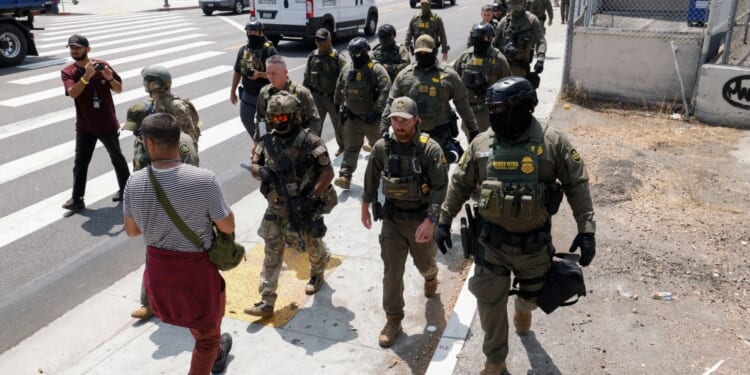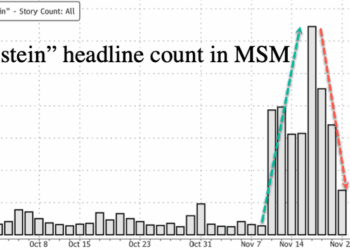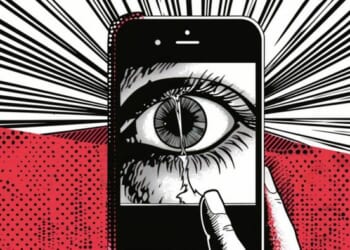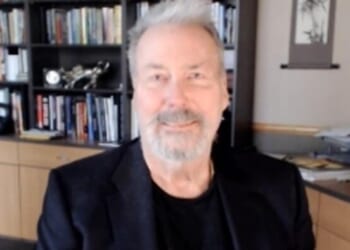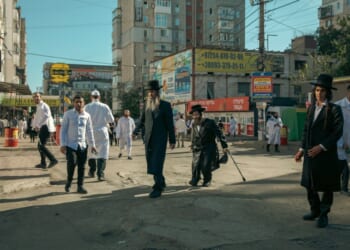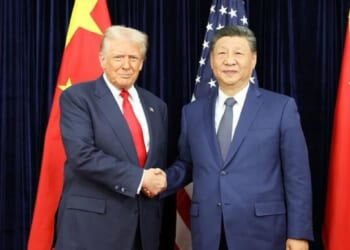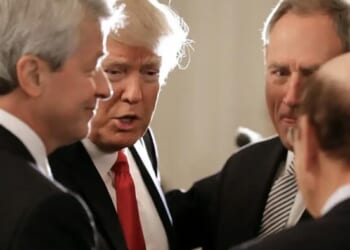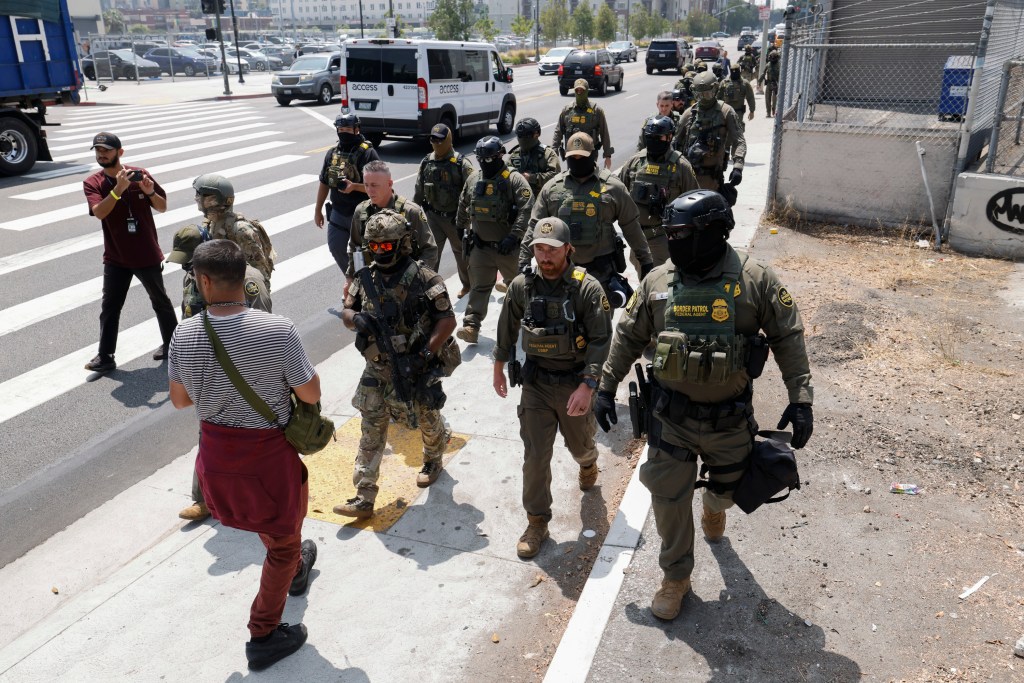
The Trump administration last month made explicit what it has been implying for months, namely that it considers videotaping ICE raids to be illegal and intends to go after those who do it. The administration is, effectively, preparing to defy current law: Federal courts have overwhelmingly held that the First Amendment protects the right to record police activity in public spaces.
Writing in The American Prospect, Matthew Cunningham-Cook reports that in response to an inquiry from the Center for Media and Democracy, Department of Homeland Security spokeswoman Tricia McLaughlin said, “Videotaping ICE law enforcement and posting photos and videos of them online is doxing our agents” and added: “We will prosecute those who illegally harass ICE agents to the fullest extent of the law.”
Numerous reports from raid scenes suggest that ICE agents are already informally “enforcing” their disapproval of at-the-scene recording by shoving, beating and even shooting (with less lethal munitions) journalists, freelance photographers, and others with cellphone cameras. Bad things seem to happen especially often when persons who make a practice of filming raids are themselves noncitizens.
If you buy the DHS line, the officers who injured journalists after seeing them recording may have been acting in, well, self-defense. Cunningham-Cook cites a press briefing in July at which DHS Secretary Kristi Noem stated that “violence” is “anything that threatens [DHS agents] and their safety. It is doxing them. It is videotaping them where they’re at.” If we’re using Noem’s standard, maybe the officers were just responding with counterviolence to the violence of being filmed.
Fortunately, the courts aren’t on board with that sort of nonsense. While the Supreme Court itself hasn’t yet faced the issue squarely, the six federal circuits that have done so—the 1st, 3rd, 5th, 7th, 9th, and 11th—all agree that the First Amendment protects the right to record police performing their duties in public. Those circuits cover such populous states as California, Texas, Florida, Illinois, New Jersey, Georgia, and Pennsylvania.
Police advocates have argued for laws and rules against recording, contending variously that it violates privacy laws, could tip off would-be criminals, and endangers police. Today’s most popular claim is that it constitutes “doxing,” and supposedly enables database-savvy bad guys to pinpoint cops’ places of residence and unleash mayhem there. (From the way this specter dominates DHS rhetoric, you’d think it had been documented to happen frequently in contemporary America.)
While courts have carved out a few reasonable exceptions—civilians on the scene have no right to physically interfere with police movements and must respect reasonable perimeters if set—they typically have not gone along with claims that videotaping law enforcement crosses any lines.
In fact, many actions that disclose to the world someone’s identity—police officer or otherwise—constitute fully protected speech (see this FIRE explainer). Like many other kinds of ordinarily protected speech, doxing can be subject to legal consequences if it is accompanied by unprotected speech such as calls for imminent lawless action, stalking, and so forth.
But where no such intended use for the identification can be shown, the mere speculation that some third party will misuse it isn’t enough to defeat the obvious and systematic public interest in enabling effective public oversight of police operations and in controlling police misbehavior—in particular, identifying which employees acting in the name of the citizenry have engaged in which actions.
Significantly, courts have been inclined to protect the right to stream images or video to the public as events unfold, rather than only after a tense situation has ended. Were livestreaming to be prohibited, the 9th Circuit ruled in a 1994 case, “immediate speech [could] no longer respond to immediate issues.” That entails by extension the right to inform a remote audience in real time, by such nonrecording means as speaking or texting from the scene, that police are present at a particular place and basic details about them.
Nor is it only reporters who have a right to record. Courts have upheld the right to film of random bystanders, as well as of activists and local officials drawn to the scene because they are keen to document police misconduct.
This last is important because ICE and its allies have been campaigning in recent months to put elected Democratic officials such as Connecticut state Rep. Corey Paris, Arizona state Sen. Analise Ortiz (a former reporter), and former Florida state Sen. Linda Stewart in legal jeopardy as well as other kinds of trouble on even thinner grounds, for doing things like announcing to their communities that ICE is in town and urging them to consider staying indoors.
The right to record in real time is also important because the FCC under speech-antagonistic chair Brendan Carr, as I’ve reported elsewhere, is invoking its seemingly infinitely elastic “public interest” standard to harass San Francisco radio station KCBS over having reported the location and car models of police during a raid in East San Jose.
And finally, explicit acknowledgement of a right to record is important because street-level officers in policing generally—as immigration enforcers are doing now—have been known to resort to informal methods of repression, threatening or roughing up persons they see using cameras, or demanding that they delete the footage or hand over their phones or tablets. That behavior in this category can itself endanger the rule of law hardly needs spelling out; as the Supreme Court put it in a 1987 case, “The freedom of individuals verbally to oppose or challenge police action without thereby risking arrest is one of the principal characteristics by which we distinguish a free nation from a police state.”
As the 3rd Circuit pointed out in the 2017 case of Fields v. Philadelphia, filming police serves goals of truth, public information, and accountability central to First Amendment law and to a free republic. As everyone knows, videos of police activity in recent years have often cast doubt on official accounts or fueled public anger and movements for reform—among the reasons the First Amendment is there in the first place.
ICE officials and some of their allies like to spread the accusation—one that, as regards their mainstream critics, is both false and poisonous —that the reason people want to photograph police activity, or unmask the balaclava-wearing toughs who pull people into unmarked vans on the street, is to promote violence against them. But when we civil reformers talk of the vital role recording plays in deterring police abuse, the repercussions we have in mind are peaceful ones consistent with the rule of law: legal remedies against individual wrongdoers, the mobilization of public opinion, reputation, and shaming, and the marshaling of political and legal pressure to cease brutal practices. Little of this can take place without a means of accurately identifying who has misbehaved, in uniform or out. Cut that off, and we are left—dress it up with what language you like—with the makings of a secret police.

